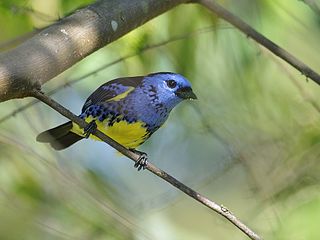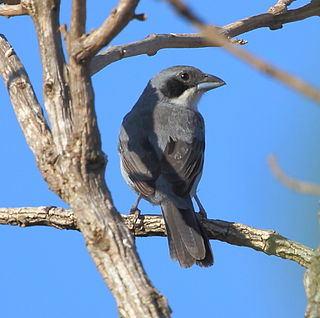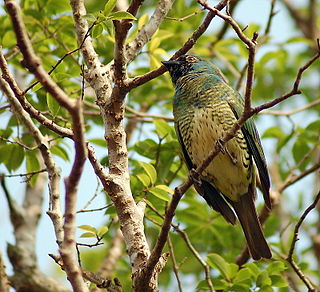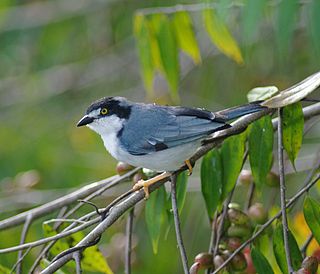
The Brazilian teal or Brazilian duck is the only duck in the genus Amazonetta. It is widely distributed in eastern South America.

The rufous-browed peppershrike is a passerine bird in the vireo family. It is widespread and often common in woodland, forest edge, and cultivation with some tall trees from Mexico and Trinidad south to Argentina and Uruguay.

The turquoise tanager is a medium-sized passerine bird in the tanager family Thraupidae. It is a resident bird from Trinidad, much of Brazil, Colombia and Venezuela south to Bolivia. It is restricted to areas with humid forest, with its primary distribution being the Amazon. It was formerly treated as being conspecific with the white-bellied tanager which is found in the Atlantic Forest of eastern Brazil.

The crimson-crested woodpecker is a species of bird in subfamily Picinae of the woodpecker family Picidae. It is found in Panama, Trinidad, and in every mainland South American country except Chile and Uruguay.

The bay-headed tanager is a medium-sized passerine bird. This tanager is a resident breeder in Costa Rica, Panama, South America south to Ecuador, Bolivia and north-western Brazil, and on Trinidad.

The saffron finch is a tanager from South America that is common in open and semi-open areas in lowlands outside the Amazon Basin. They have a wide distribution in Colombia, northern Venezuela, western Ecuador, western Peru, eastern and southern Brazil, Bolivia, Paraguay, Uruguay, northern Argentina, and Trinidad and Tobago. It has also been introduced to Hawaii, Panama, Puerto Rico and elsewhere. Although commonly regarded as a canary, it is not related to the Atlantic canary. Formerly, it was placed in the Emberizidae but it is close to the seedeaters.

The shrike-like tanager, also known as the white-banded tanager, is a South American bird in the tanager family Thraupidae. It is the only member of the genus Neothraupis.

The magpie tanager is a South American species of tanager. It is the only member of the monotypic genus Cissopis. As suggested by its common name, this blue-black and white species is superficially reminiscent of a European magpie. With a total length of 25–30 cm (9.8–11.8 in), a large percentage of which is tail, it is the longest species of tanager. It weighs 69–76 g (2.4–2.7 oz).

The scarlet-throated tanager is a small passerine bird in the tanager family Thraupidae that is endemic to eastern Brazil. It is the only member of the genus Compsothraupis.

The roadside hawk is a relatively small bird of prey found in the Americas. This vocal species is often the most common raptor in its range. It has many subspecies and is now usually placed in the monotypic genus Rupornis instead of Buteo.

The swallow tanager is a species of Neotropic bird in the tanager family Thraupidae. It is the only member of the genus Tersina. It is found widely throughout South America, from eastern Panama to far northern Argentina. The species is sexually dimorphic: the female is a yellow-green and the male a turquoise blue with a small deep black face and upper throat patch.

The sapphire-rumped parrotlet is a species of bird in subfamily Arinae of the family Psittacidae, the African and New World parrots. It is found in Brazil, Colombia, Ecuador, French Guiana, Guyana, Peru, Suriname, and Venezuela.

The white-banded swallow is a species of bird in the family Hirundinidae. It is black with white thighs, a white breast, and has white bars on the edges of its wings. It has a distinct, deeply forked tail.

The cliff flycatcher is a species of bird in the tyrant flycatcher family, Tyrannidae. The cliff flycatcher is the only species in the genus Hirundinea after the swallow flycatcher was merged, becoming subspecies Hirundinea ferruginea bellicosa. It is native to South America, where its natural habitats are cliffs and crags in the vicinity of subtropical or tropical dry forest, subtropical or tropical moist lowland forest, subtropical or tropical moist montane forest, and heavily degraded former forest.

The hooded tanager is a species of bird in the tanager family Thraupidae. It is found in Argentina, Bolivia, Brazil, Colombia, French Guiana, Guyana, Paraguay, Peru, and Venezuela. Its natural habitats are subtropical or tropical moist lowland forest, subtropical or tropical mangrove forest, and heavily degraded former forest.

The flame-crested tanager is a species of bird in the family Thraupidae. It is found in Bolivia, Brazil, Colombia, Ecuador, French Guiana, Guyana, Peru, Suriname, and Venezuela. Its natural habitats are subtropical or tropical moist lowland forests and subtropical or tropical dry shrubland. Ten subspecies are currently recognized.

The burnished-buff tanager, also known as the rufous-crowned tanager, is a common South American species of bird in the family Thraupidae.

The spotted tanager is a species of bird in the tanager family Thraupidae. It is found in Bolivia, Brazil, Ecuador, French Guiana, Guyana, Peru, Suriname, and Venezuela. Its natural habitats are subtropical or tropical moist lowland forests and subtropical or tropical moist montane forests.

The opal-rumped tanager is a species of bird in the family Thraupidae. It is found in the Amazon and Atlantic Forest of South America. The population of the Atlantic Forest has a far paler chest than the other populations, and has often been considered a separate species as the silvery-breasted tanager. Today most authorities treat it as a subspecies of the opal-rumped tanager.

The sayaca tanager is a species of bird in the family Thraupidae, the tanagers. It is a common resident in northeastern, central, and southeastern Brazil, and Bolivia, Paraguay, Uruguay, and northeastern Argentina. A few are recorded from far southeastern Peru, but its status there is unclear, in part due to the potential of confusion with the very similar juveniles of the blue-grey tanager.






















